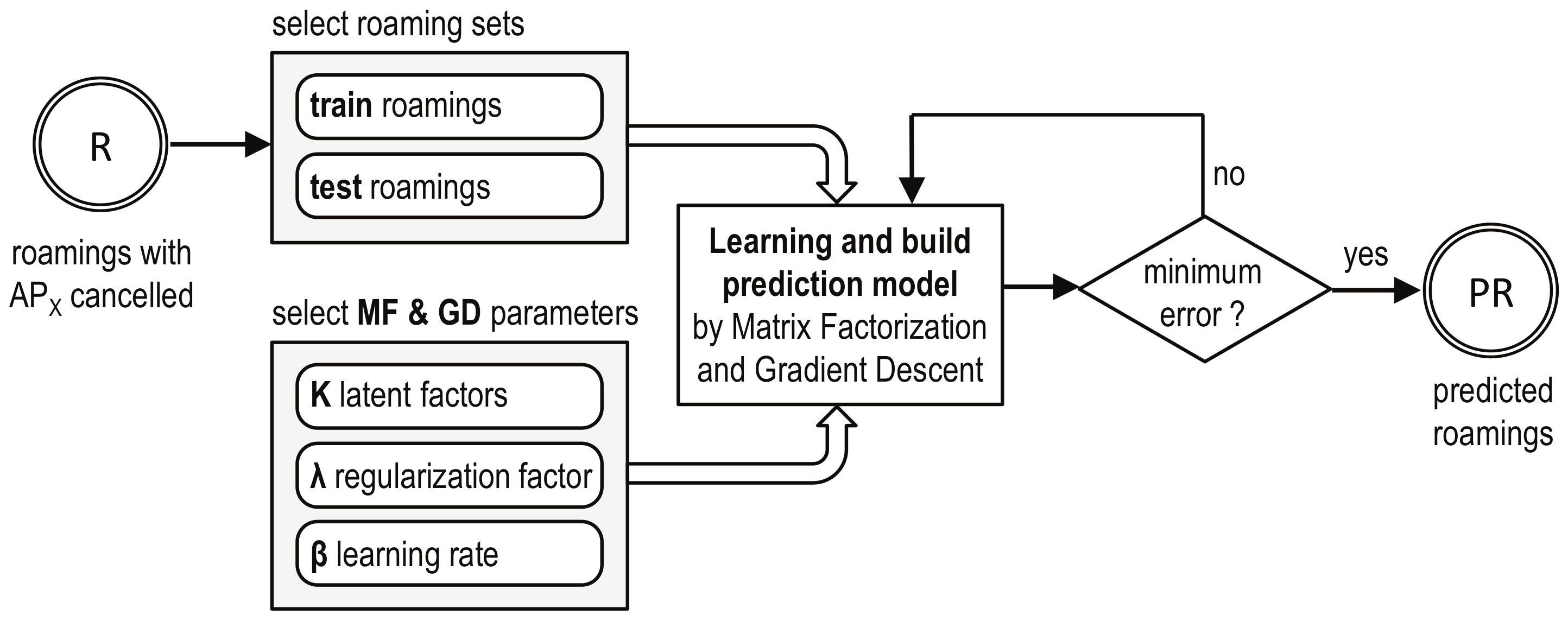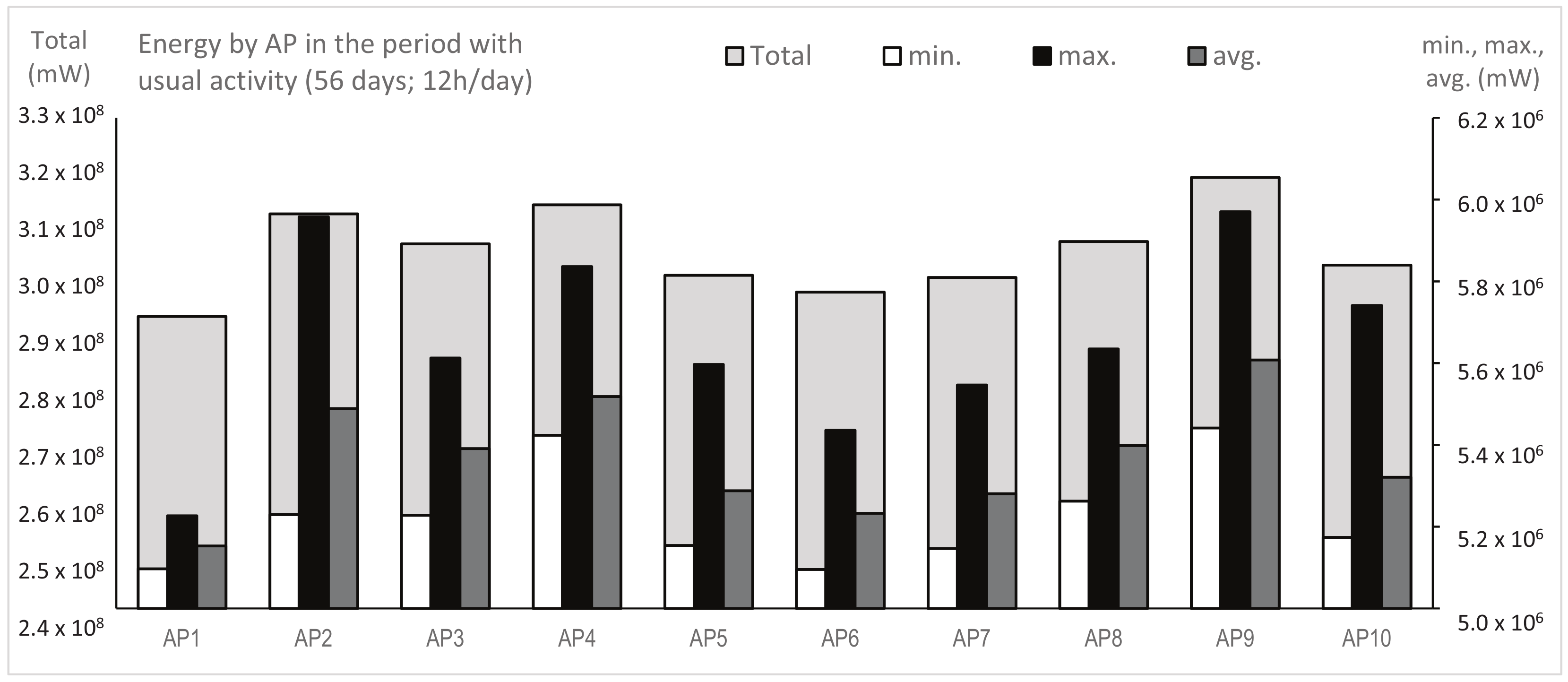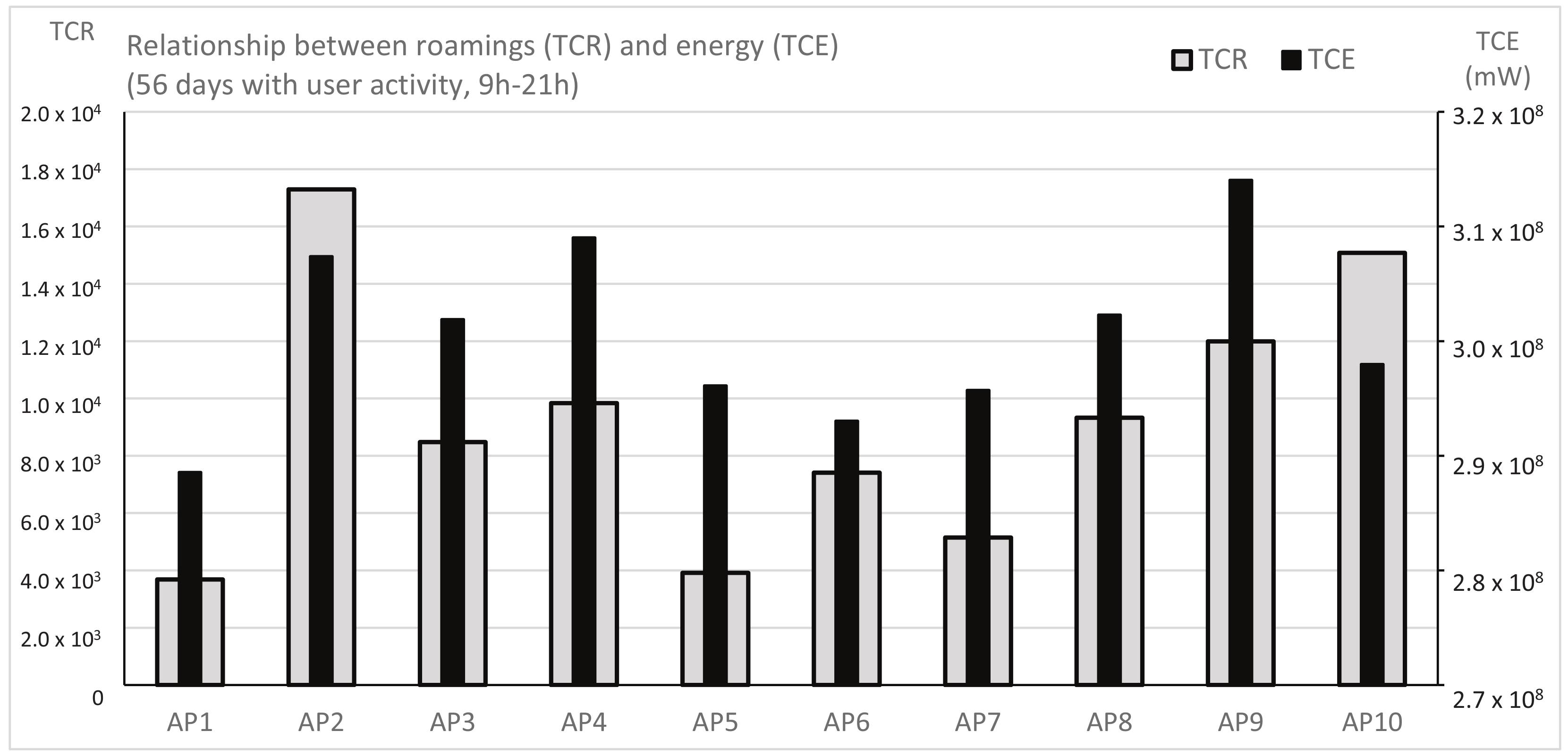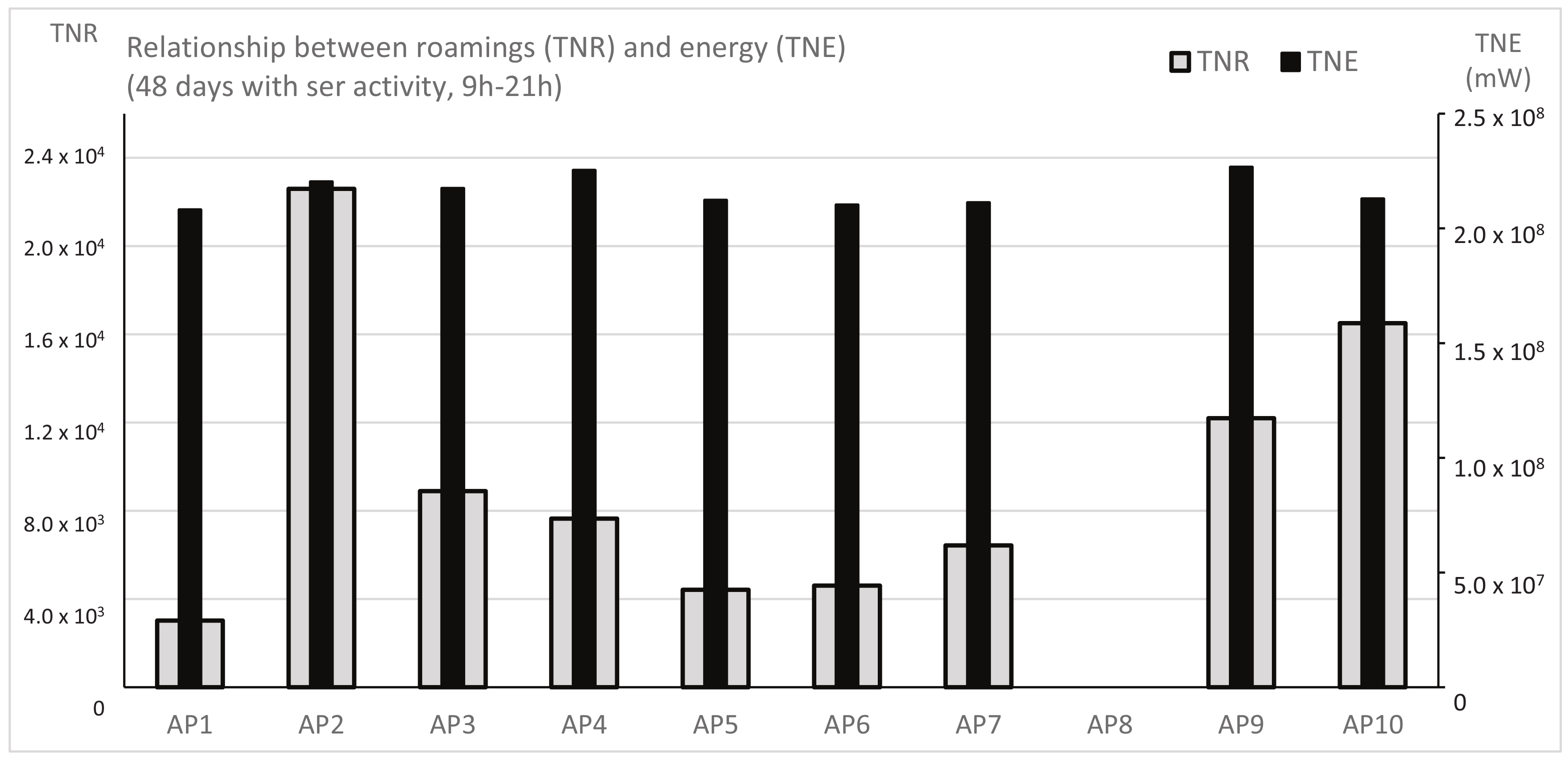Energy Prediction of Access Points in Wi-Fi Networks According to Users’ Behaviour
Abstract
:1. Introduction
2. Related Works
3. An Energy Prediction Proposal
3.1. Current Network Status and Relationship between Energy and Roamings
3.2. Predicting Roamings after Removing an Access Point
3.3. Energy Prediction for the Simulated Network
4. Experimental Environment
4.1. Access Point Technology
4.2. Collecting Data
- Period: 73 days.
- Start time: 28 November 2016, at 00 h:00 m:01 s.
- End time: 8 February 2017, at 23 h:59 m:01 s.
- Sampling interval: 60 s.
- Total energy measures collected: 1,048,240 samples = 104,824 samples by AP.
5. Data Analysis
5.1. Total Energy Used in the Access Points in the Period
5.2. Energy Use by AP in the Period
6. Energy Prediction
7. Experimental Validation
- (“New Roamings”). It is a matrix, where S is the number of users () and I is the number of APs (). The cell is the number of total roamings due to user s in the AP i during the entire period. As was removed, the entire column is set to zero in the matrix.
- (“Total New Roamings”). It is an array of size I where is the number of roamings stablished in the AP i by all the users during the period. This value is calculated by adding the entire column i in .
- (“Total New Energy”). It is an array of size I where is the total energy in the AP i in the period. As in the prediction, the energy values in this array are filtered to consider only the period (40 days) where the network was available for the users. Therefore, we assure these energy values show the users’ behaviour.
8. Discussion
Acknowledgments
Author Contributions
Conflicts of Interest
Abbreviations
| AP | Access Point |
| Learning Rate | |
| C | Point Coefficients for simulated network |
| CN | Point Coefficients for new network |
| CNR | Current Roamings matrix of new network |
| CR | Current Roamings matrix |
| Set of known roamings | |
| Set of test roamings | |
| Set of training roamings | |
| Set of unknown roamings | |
| GD | Gradient Descent |
| I | Number of Access Points |
| Regularisation Term | |
| MF | Matrix Factorisation |
| PR | Predicted Roamings matrix |
| R | Roamings matrix |
| RMSE | Root Mean Squared Error |
| RS | Recommender Systems |
| S | Number of network users |
| TCE | Total Current Energy |
| TCR | Total Current Roamings |
| TNE | Total New Energy |
| TNR | Total New Roamings |
| TPE | Total Predicted Energy |
| TPR | Total Predicted Roamings |
| UEX | University of Extremadura, Spain |
| WSN | Wireless Sensor Network |
References
- Petroski, J. Power over Ethernet thermal analysis with an engineering mechanics approach. In Proceedings of the 2016 32nd Thermal Measurement, Modeling Management Symposium (SEMI-THERM), San Jose, CA, USA, 14–17 March 2016; pp. 50–56. [Google Scholar]
- Jannach, D.; Zanker, M.; Friedrich, G. Recommender Systems: An Introduction; Cambridge University Press: Cambridge, UK, 2011. [Google Scholar]
- Hamamoto, R.; Takano, C.; Obata, H.; Aida, M.; Ishida, K. Setting Radio Transmission Range Using Target Problem to Improve Communication Reachability and Power Saving. In Ad Hoc Networks, Proceedings of the 7th International Conference (AdHocHets 2015), San Remo, Italy, 1–2 September 2015; Mitton, N., Kantarci, M.E., Gallais, A., Papavassiliou, S., Eds.; Springer: Cham, Switzerland, 2015; pp. 15–28. [Google Scholar]
- Konstantinidis, A.; Yang, K. Multi-objective K-connected Deployment and Power Assignment in WSNs using a problem-specific constrained evolutionary algorithm based on decomposition. Comput. Commun. 2011, 34, 83–98. [Google Scholar] [CrossRef]
- Venckauskas, A.; Jusas, N.; Kazanavicius, E.; Stuikys, V. Identification of Dependency among Energy Consumption and Wi-Fi Protocol Security Levels within the Prototype Module for the IoT. Elektron. Elektrotech. 2014, 20, 132–135. [Google Scholar]
- Zhang, H.; Chu, X.; Guo, W.; Wang, S. Coexistence of Wi-Fi and heterogeneous small cell networks sharing unlicensed spectrum. IEEE Commun. Mag. 2015, 53, 158–164. [Google Scholar] [CrossRef]
- He, H.; Shan, H.; Huang, A.; Cai, L.X.; Quek, T. Proportional Fairness-Based Resource Allocation for LTE-U Coexisting with Wi-Fi. IEEE Access 2016, 5, 4720–4731. [Google Scholar] [CrossRef]
- Shen, Y.; Jiang, C.; Quek, T.Q.S.; Zhang, H.; Ren, Y. Pricing equilibrium for data redistribution market in wireless networks with matching methodology. In Proceedings of the 2015 IEEE International Conference on Communications (ICC), London, UK, 8–12 June 2015; pp. 3051–3056. [Google Scholar]
- Scellato, S.; Musolesi, M.; Mascolo, C.; Latora, V.; Campbell, A.T. NextPlace: A Spatio-temporal Prediction Framework for Pervasive Systems. In Pervasive Computing, Proceedings of the 9th International Conference (Pervasive 2011), San Francisco, CA, USA, 12–15 June 2011; Lyons, K., Hightower, J., Huang, E.M., Eds.; Springer: Berlin/Heidelberg, Germany, 2011; pp. 152–169. [Google Scholar]
- Hamamoto, R.; Takano, C.; Obata, H.; Ishida, K. Improvement of Throughput Prediction Method for Access Point in Multi-rate WLANs Considering Media Access Control and Frame Collision. In Proceedings of the 2015 Third International Symposium on Computing and Networking (CANDAR), Sapporo, Japan, 8–11 December 2015; pp. 227–233. [Google Scholar]
- Dai, L.; Xue, Y.; Chang, B.; Cao, Y.; Cui, Y. Integrating Traffic Estimation and Routing Optimization for Multi-Radio Multi-Channel Wireless Mesh Networks. In Proceedings of the 27th Conference on Computer Communications (INFOCOM 2008), Phoenix, AZ, USA, 13–18 April 2008. [Google Scholar]
- Baker, T.; Al-Dawsari, B.; Tawfik, H.; Reid, D.; Ngoko, Y. GreeDi: An energy efficient routing algorithm for big data on cloud. Ad Hoc Netw. 2015, 35, 83–96. [Google Scholar] [CrossRef]
- Baker, T.; Ngoko, Y.; Tolosana-Calasanz, R.; Rana, O.F.; Randles, M. Energy Efficient Cloud Computing Environment via Autonomic Meta-director Framework. In Proceedings of the 2013 Sixth International Conference on Developments in eSystems Engineering, Abu Dhabi, UAE, 16–18 December 2013; pp. 198–203. [Google Scholar]
- François, J.M.; Leduc, G. AP and MN-Centric Mobility Prediction: A Comparative Study Based on Wireless Traces. In NETWORKING 2007. Ad Hoc and Sensor Networks, Wireless Networks, Next Generation Internet: 6th International IFIP-TC6 Networking Conference, Atlanta, GA, USA, 14–18 May 2007, Proceedings; Akyildiz, I.F., Sivakumar, R., Ekici, E., Oliveira, J.C.D., McNair, J., Eds.; Springer: Berlin/Heidelberg, Germany, 2007; pp. 322–332. [Google Scholar]
- Gmach, D.; Rolia, J.; Cherkasova, L.; Kemper, A. Workload Analysis and Demand Prediction of Enterprise Data Center Applications. In Proceedings of the 2007 IEEE 10th International Symposium on Workload Characterization, Boston, MA, USA, 27–29 September 2007; IEEE Computer Society: Washington, DC, USA, 2007; pp. 171–180. [Google Scholar]
- Ghosh, A.; Jana, R.; Ramaswami, V.; Rowland, J.; Shankaranarayanan, N.K. Modeling and characterization of large-scale Wi-Fi traffic in public hot-spots. In Proceedings of the 2011 IEEE INFOCOM, Shanghai, China, 10–15 April 2011; pp. 2921–2929. [Google Scholar]
- Duggan, J.; Chi, Y.; Hacigumus, H.; Zhu, S.; Cetintemel, U. Packing light: Portable workload performance prediction for the cloud. In Proceedings of the International Conference on Data Engineering, Brisbane, Australia, 8–12 April 2013; pp. 258–265. [Google Scholar]
- Younis, M.; Akkaya, K. Strategies and techniques for node placement in wireless sensor networks—A survey. Ad Hoc Netw. 2008, 6, 621–655. [Google Scholar] [CrossRef]
- Vilovic, I.; Burum, N. Location Optimization of WLAN Access Points Based on a Neural Network Model and Evolutionary Algorithms. J. Control Meas. Electron. Comput. Commun. 2014, 55, 317–329. [Google Scholar] [CrossRef]
- Rodriguez-Lozano, D.; Gomez-Pulido, J.; Lanza-Gutierrez, J.; Duran-Dominguez, A.; Fernandez-Diaz, R. Context-aware prediction of access points demand in Wi-Fi networks. Comput. Netw. 2017, 117, 52–61. [Google Scholar] [CrossRef]
- Koren, Y.; Bell, R.; Volinsky, C. Matrix Factorization Techniques for Recommender Systems. Computer 2009, 42, 30–37. [Google Scholar] [CrossRef]
- Bottou, L. Large-Scale Machine Learning with Stochastic Gradient Descent. In Proceedings of the 19th International Conference on Computational Statistics, Paris, France, 22–27 August 2010; Springer: Heidelberg, Germany, 2010; pp. 177–186. [Google Scholar]
- Zhang, R.; Gong, W.; Grzeda, V.; Yaworski, A.; Greenspan, M. An Adaptive Learning Rate Method for Improving Adaptability of Background Models. IEEE Signal Process. Lett. 2013, 20, 1266–1269. [Google Scholar] [CrossRef]
- Ranganath, R.; Wang, C.; Blei, D.M.; Xing, E.P. An Adaptive Learning Rate for Stochastic Variational Inference. In Proceedings of the 30th International Conference on Machine Learning, Atlanta, GA, USA, 17–19 June 2013; pp. 1–9. [Google Scholar]










© 2017 by the authors. Licensee MDPI, Basel, Switzerland. This article is an open access article distributed under the terms and conditions of the Creative Commons Attribution (CC BY) license (http://creativecommons.org/licenses/by/4.0/).
Share and Cite
Rodriguez-Lozano, D.; Gomez-Pulido, J.A.; Lanza-Gutierrez, J.M.; Duran-Dominguez, A.; Crawford, B.; Soto, R. Energy Prediction of Access Points in Wi-Fi Networks According to Users’ Behaviour. Appl. Sci. 2017, 7, 825. https://doi.org/10.3390/app7080825
Rodriguez-Lozano D, Gomez-Pulido JA, Lanza-Gutierrez JM, Duran-Dominguez A, Crawford B, Soto R. Energy Prediction of Access Points in Wi-Fi Networks According to Users’ Behaviour. Applied Sciences. 2017; 7(8):825. https://doi.org/10.3390/app7080825
Chicago/Turabian StyleRodriguez-Lozano, David, Juan A. Gomez-Pulido, Jose M. Lanza-Gutierrez, Arturo Duran-Dominguez, Broderick Crawford, and Ricardo Soto. 2017. "Energy Prediction of Access Points in Wi-Fi Networks According to Users’ Behaviour" Applied Sciences 7, no. 8: 825. https://doi.org/10.3390/app7080825
APA StyleRodriguez-Lozano, D., Gomez-Pulido, J. A., Lanza-Gutierrez, J. M., Duran-Dominguez, A., Crawford, B., & Soto, R. (2017). Energy Prediction of Access Points in Wi-Fi Networks According to Users’ Behaviour. Applied Sciences, 7(8), 825. https://doi.org/10.3390/app7080825







